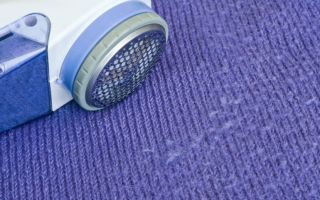Content
- 1 Why do pellets appear on the coat
- 2 How to clean a coat from pellets using folk methods
- 2.1 How to quickly remove lumps from a coat with a toothbrush
- 2.2 How to remove pellets from a coat with tape
- 2.3 How to use scissors to remove lumps from your coat
- 2.4 How to remove the pellets from a coat with a razor
- 2.5 How to use a comb to remove pills from your coat
- 2.6 How to clean the pellets from a coat at home with crackers
- 2.7 How to get rid of coats of coats with sandpaper
- 2.8 How to quickly get rid of pellets on a coat with a washcloth
- 3 How to remove the pellets from a coat with a machine
- 4 Dry cleaning your coat
- 5 How to prevent pilling on your coat
- 6 Conclusion
Getting rid of the pellets on your coat is not so difficult; there are several ways to do this. To fix the problem, you need to familiarize yourself with all the methods, and at the same time find out why the pellets appear and how to prevent them.
Why do pellets appear on the coat
Woolen, cashmere or drape coat is one of the most beautiful and noble types of outerwear. Unfortunately, after a while, pellets inevitably appear on things, and as their number increases, the clothes lose their attractiveness.
Small clumps appear due to the fact that individual fibers of the fabric lose their smoothness and begin to loosen. This does not affect the practical convenience of the clothes, the product remains the same warm, the threads do not break, and holes do not appear on things. But microscopic loose villi gradually roll into small lumps, which are called pellets.
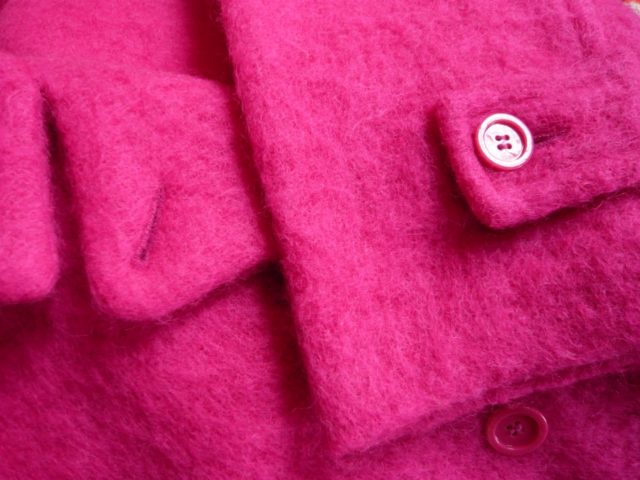
The appearance of pellets provokes several factors:
- Improper coat care. If you machine wash clothes that are intended to be hand-washed, use too caustic powder or violate the recommendations for drying things, then lumps will appear very quickly, as the fibers begin to lose their integrity.
- Careless wearing. If individual parts of the product, for example, elbows, floors or pockets, often rub against any surface, then the fabric in these places quickly begins to shaggy and becomes covered with pellets.
- Manufacturing defects in the manufacture of things. If the threads of the fabric are twisted too loosely, then lumps will appear very quickly, even with careful wear.
Pills almost inevitably occur on all types of coats. But they become noticeable faster on woolen clothes, which, moreover, have hardly undergone chemical treatment during the production process. The fibers of such fabric are more sensitive to mechanical stress and moisture changes.
How to clean a coat from pellets using folk methods
If lumps of fabric become noticeable on a product, this does not mean that the thing is hopelessly damaged. It is quite possible for clothes to return a neat and presentable look. This can be done in several simple homemade ways.
How to quickly remove lumps from a coat with a toothbrush
You can easily remove the pellets from your woolen coat with an old toothbrush. This method works especially well if the pile of the product is long.
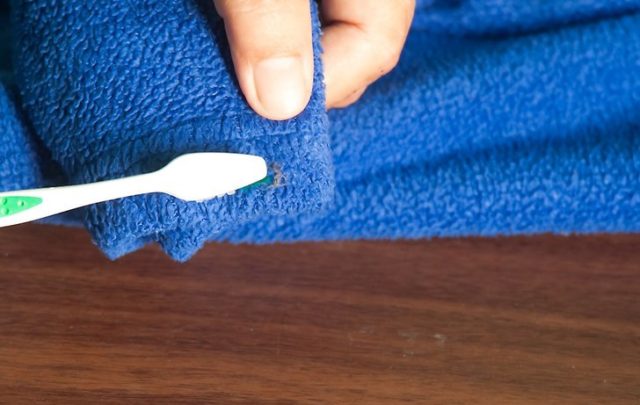
To remove the pellets, you need to take a dry brush and run it several times along the fabric fibers with light pressure. The brush in the process of movement will pick up the lumps and carry them along, leaving only a smooth and clean cloth.
The disadvantage of this method is that cleaning the product with a small brush can take a long time. It is better to use the method in cases where there are not too many lumps on the coat, and they are noticeable only in certain places.
How to remove pellets from a coat with tape
Another way to remove clumps from your coat is to tape the loose areas of the fabric. It is best to take a wide tape, it will be more convenient to use it and you will get the result faster.
Apply adhesive tape as follows:
- adhesive tape is glued to the desired area of the product;
- smoothed several times so that the sticky surface is pressed against the fabric more tightly;
- tear off the tape with a sharp movement.
The principle of operation is the same as during epilation - the pellets are reliably glued to the sticky surface, and then come off the fabric when removing the tape. The method works best if the pellets on the coat have just formed and are not yet too noticeable, it is quite easy to remove them with tape.
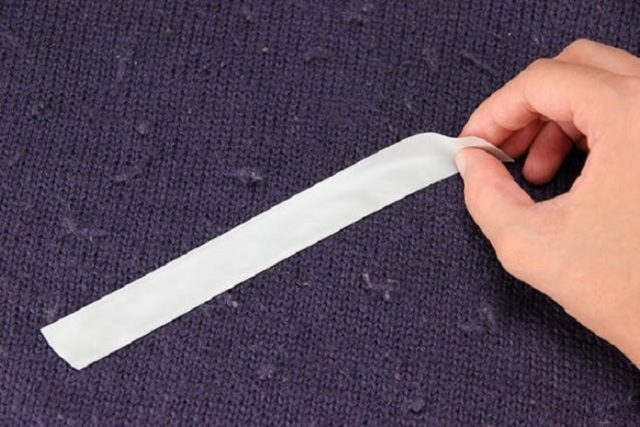
How to use scissors to remove lumps from your coat
A reliable option for removing lumps from the surface of the fabric is to use sharp scissors for this purpose. It is necessary to spread the product on a flat surface, smooth out the necessary places and, if necessary, lightly comb the pile. After that, the lumps are simply cut off with scissors separately.
Scissors are a very effective way to deal with clumps, but not very convenient. Coats are time consuming to clean as each pellet has to be handled by hand. In addition, there is a great risk of damaging the product if you move it carelessly. It is recommended to use this method if there are relatively few pellets on things, and they are rather large, so that other cleaning methods do not work.
How to remove the pellets from a coat with a razor
Using a razor is an effective, fast, but dangerous way to remove lumps from drape or wool fabric. The product is straightened on a table or on an ironing board and the fabric is properly stretched, after which they make several quick but neat movements from the bottom up. The razor blade cuts off the pellets, leaving the coat fabric smooth and clean.
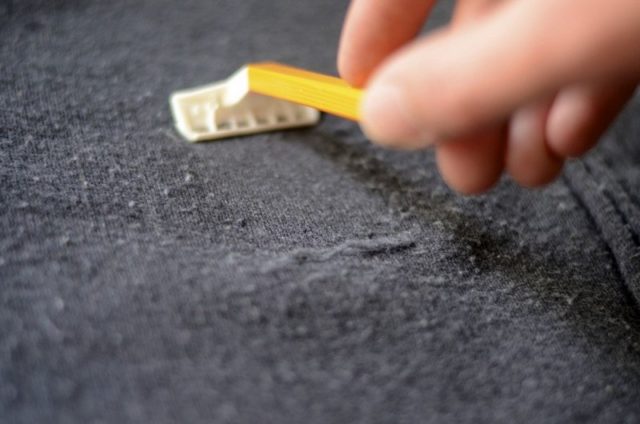
Great care must be taken when using the razor to avoid damaging the fibers. It is not recommended to direct the movements from top to bottom, as the risk of accidentally cutting the coat is much higher. In addition, it is better to take a not new razor. A slightly dull, but still lint-cutting blade is ideal for removing pellets.
How to use a comb to remove pills from your coat
If a coat with a long pile has rolled, you can use a regular comb, its teeth should be frequent and short. The fabric should be spread out on an even place and the comb should be passed along the fibers with slight pressure. The teeth of the comb will grip the pellets and remove them from the surface of the fabric, provided they are large enough to get stuck between the teeth.
The option is considered quick and safe for a coat, but more often than not it does not give one hundred percent result.Therefore, after using the comb, it is recommended to additionally treat the clothes with adhesive tape or a toothbrush, this will remove and eliminate the remaining lumps.
How to clean the pellets from a coat at home with crackers
If your new woolen coat is lumpy, you don't need to use a razor or scissors to remove small lumps. An excellent effect will be brought by ordinary bread crumbs dried in the oven or in a pan without the use of oil.
Use a rusk in much the same way as a razor or scotch tape. The rolled product is stretched on a convenient horizontal surface, after which the biscuit is pulled with effort over the pellets in the direction from top to bottom. The effect is achieved due to the fact that dried bread has a hard, rough and porous surface - the lumps cling to the biscuit and come off the fabric.

It is almost impossible to damage the woolen coat in this way, so the use of a biscuit is considered safe. After cleaning, all that remains is to shake off the crumbs.
How to get rid of coats of coats with sandpaper
You can use sandpaper to clean coarse fabrics - it is quite effective at removing pills and leaving behind a clean and even cloth. The rolled coat must be laid out horizontally on the table, properly straightened, and then sandpaper several times over those places where lumps are noticeable.
When processing, you need to adhere to several rules:
- use only fine-grained sandpaper, a coarse-grained sandpaper will be able to remove the pellets, but at the same time it will most likely damage the fabric itself;
- do not rub the same place on clothes with force - movements should be long, smooth and light so that the fibers of the fabric do not get unnecessary damage;
- Do not use sandpaper on delicate, delicate fabrics such as cashmere or wool.
Emery is best suited for cleaning a drape coat. If, after processing, slight weak lumps remain on the surface of the fabric, it is better to remove them using other methods. Excessive use of sandpaper can damage whole fibers of the fabric, and, accordingly, new lumps appear very quickly.
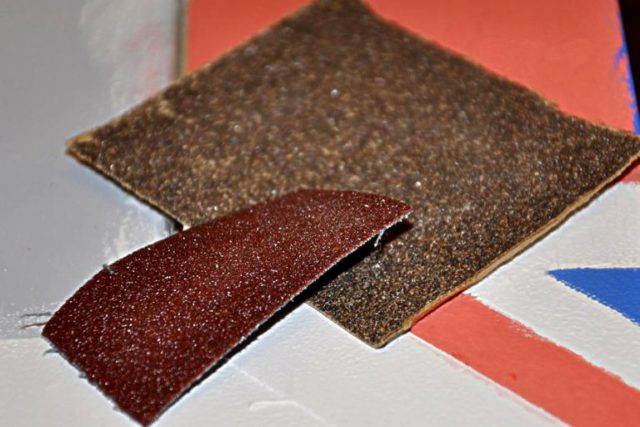
How to quickly get rid of pellets on a coat with a washcloth
Use a stiff washcloth to remove lumps from your polyester or cashmere coat. Its structure is rough, but soft enough not to damage sensitive material.
As in all previous cases, the coat should be laid flat on an ironing board or on a table, straightened and stretched slightly with your hands, and then rubbed with a dry washcloth. It is better to take a new, never used sponge, its texture retains optimal rigidity. You need to make movements in the direction of the fibers.
How to remove the pellets from a coat with a machine
One of the best methods for getting rid of pellets is to use a special clipper. The compact device is equipped with numerous miniature blades with adjustable height, which allows you to adjust the clipper so that it does not exactly damage the fabric during cleaning.
You need to use the machine according to the instructions. Usually, the device is placed parallel to the laid out fabric, the coat is stretched and, holding it with one hand, is carried out with the typewriter through problem areas. It is not necessary to press the device strongly against the fabric; a very light touch is enough for the machine to do its job.
The method is good because it allows you to remove lumps from clothes very quickly, cleanly and effortlessly.The disadvantages include the fact that, according to reviews, machines for removing pellets are poorly suited for thin sensitive tissues, they often have not only clues, but also holes.
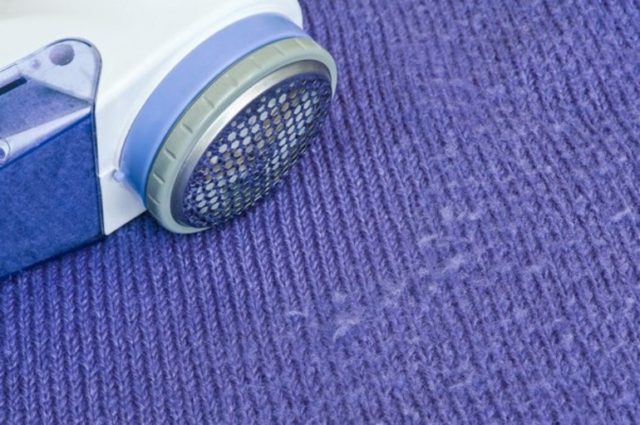
If a woolen coat or cashmere outerwear is regularly rolled, then the purchase of a machine will be justified, despite the money spent. You will have to remove lumps from clothes one way or another, the device will allow you to do this as accurately and quickly as possible.
Dry cleaning your coat
If it is necessary to remove the spools from the outerwear, but there is no time to do it yourself, you can use the services of dry cleaning. Professional workers will not only make clothes neat, but they will also be able to clean the coat at the same time, without violating the rules of care.
Under dry-cleaning conditions, lumps from outerwear are usually removed in several ways:
- using machines;
- using special brushes and combs to eliminate pellets;
- by means of special sponges with an abrasive surface.
Dry cleaning services cost money, but they provide a guarantee that the lumps will be removed really efficiently and without damage to clothes. Of course, you need to choose a dry cleaner carefully and trust your clothes only to real professionals.
How to prevent pilling on your coat
Over time, lumps appear on almost any fabric; it is almost impossible to completely insure a coat against them. But it is quite realistic to postpone the appearance of pellets and make them appear infrequently and in small quantities.
It is important to observe the following rules:
- When washing and drying, you must carefully follow the manufacturer's instructions: wash the coat only at the specified temperatures, do not load into the machine, if this cannot be done, do not dry using heaters.
- To wash outerwear, you need to use not an ordinary powder, but a washing gel with a soft composition, such a detergent will not harm the fabric and will help to extend the life of the clothes.
- When hand washing wool or cashmere coats, do not rub too hard with your hands. Mechanical impact badly affects the integrity of the tissue and leads to the appearance of pellets.
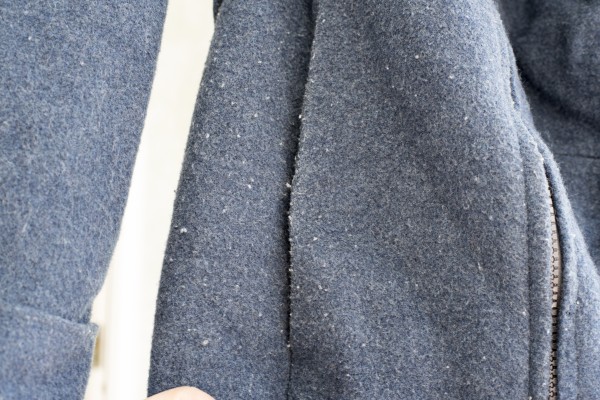
To make it easier to remove lumps from clothing, it is recommended to regularly inspect the coat in the area of the elbows, collar, armpits and pockets, where pellets appear most often. Backpacks and bags should be worn so that they have minimal contact with the fabric and do not rub too hard on its surface.
Conclusion
You can get rid of the pellets on your coat not only in dry cleaning, but also at home - there are many simple but effective ways. However, each of them requires caution in use; when removing the pellets at home, there is a risk of causing additional damage to the clothes.

